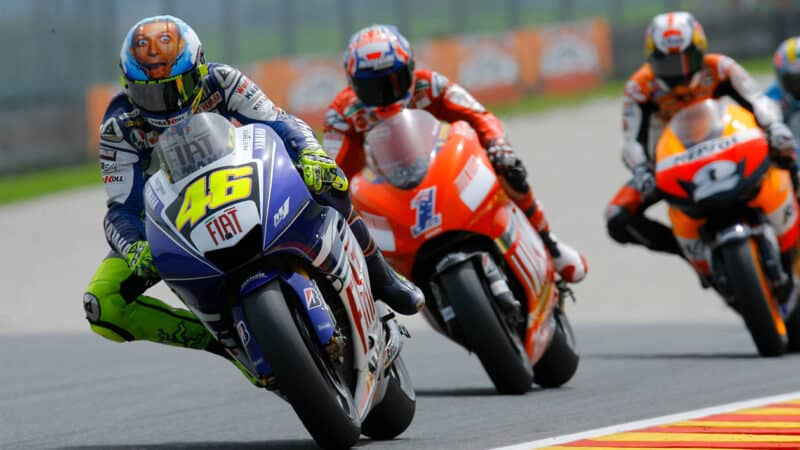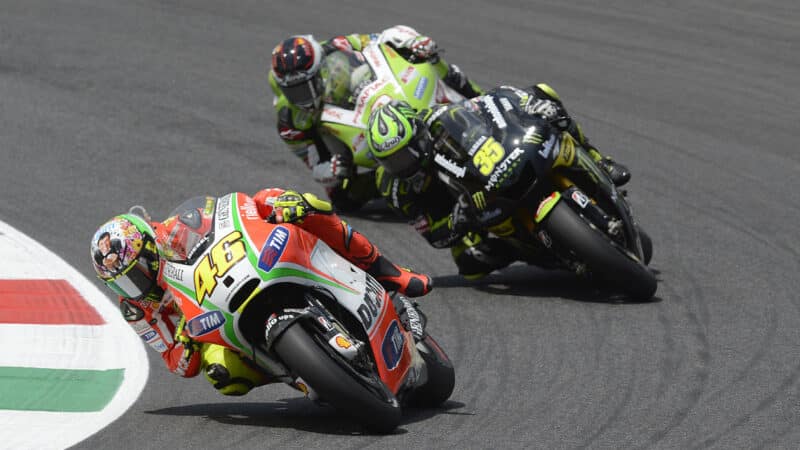“This may not seem a lot but the manufacturers reckon it will have a big impact on the amount of downforce created by the fairing,” says MotoGP technical director Danny Aldridge, who wasn’t involved in the rule-making process but enforces all tech regulations. “Moving the fairing nose back will especially have quite a big impact on downforce on the front tyre.”
Hopefully less downforce aero will also mean that motorcycles will create less wake, which should make overtaking less complicated
The initial push for the new rules – concocted by Dorna, the MSMA (the Motorcycle Sports Manufacturers Association) and MotoGP director of technology Corrado Cecchinelli – was to reduce engine performance, because top speeds are nudging towards 230mph (370km/h).
This will be achieved in several ways: by reducing engine capacity by 15%, from 1000cc to 850cc, by reducing fuel capacity by 10%, from 22 litres to 20 litres, by the introduction of 100% “non-oil-refinement origin” fuel and by requiring engines to last longer. Riders are currently allowed seven engines per season (eight, if the calendar numbers more than twenty races). From 2027 they’ll only get six (or seven).


MotoGP’s 800cc era (2007 to 2011) was mostly (but not always) characterised by processional follow-my-leader racing – Valentino Rossi leads Casey Stoner and Dani Pedrosa
AGV
These changes will come into effect a decade and a half after MotoGP engine size was increased from 800cc to 1000cc, because the peaky 800s helped cause mostly tedious follow-my-leader racing from 2007 to 2011. The 800s had been introduced because the original MotoGP 990cc four-strokes, which arrived in 2002, were considered too fast.
Will the 850s be any better? Let’s hope so. The 800cc rules didn’t include any bore and stroke restrictions, whereas the 850cc rules do. The current 1000s are allowed a maximum bore of 81mm, while the 850s will have a maximum of 75mm, so the engines will be squarer, which in theory means peakier.
However, the 850s will be allowed a third fewer gearbox ratio options, down from 24 to 16. This will reduce costs and force engine designers to create a broader spread of power, which usually makes for better racing.
Racing’s road-bike category can’t be faster than its prototype category
The biggest surprise of the new rules is that GPS (Global Positioning System) will be allowed for the first time since it was banned in 2010. But this time it’s different. GPS data – which records bike speed and position (including cornering lines) – will be available to Dorna and rival teams, not live, but after sessions and races.
This will help slower manufacturers and riders to improve but that’s not the main goal of reintroducing GPS.
“This is mainly to help Dorna on track safety,” explains Aldridge. “We have a collaboration with Padua University, working on safety. This information will tell us how fast the bikes are going when they go down and how far they travel, so it will help a lot with track design.”
Minimum weight of machines will drop four kilos to 153 kilos.
What effect will all of this have on lap times?
“The guess is between two to three seconds,” says Aldridge.
Which will obviously have a knock-on effect for World Superbike technical regulations, because bike racing’s road-bike category can’t be faster than its prototype category.


MotoGP’s last change in engine capacity took place in 2012, when the 1000s replaced the 800s – Rossi leads Cal Crutchlow and Hector Barbera
Ducati
There’s no word yet on how WSB rules will change, but WSB contestants Ducati, Honda and Yamaha sit on the MSMA, so they will already be aware of the need for change.
Will BMW, currently second in the WSB riders’ and constructors’ points chases, be encouraged to enter MotoGP under these new rules? If the German marque wants to contest the premier class there’s no better time than when the rules change.
Any new manufacturers, like BMW, will get full concessions when they enter the championship, allowing them engine upgrades and more engines, more aero upgrades, more testing, more Wild Card entries and so on.



